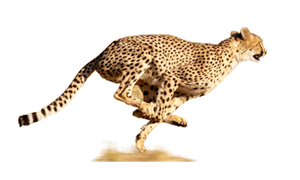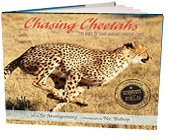Chasing Cheetahs: The Race to Save Africa’s Fastest Cat
(Scientists in the Field Series)
Houghton Mifflin Harcourt (HMH), April 2014
Even on the three-hour drive from Windhoek, the modern capitol of Namibia (the country next to South Africa and Botswana near Africa’s southern tip) we can see we’re in for a wild ride.
Shortly after we leave the city, the parade of wonders begins: thorny acacia trees hung like Christmas ornaments with the woven-straw nests of weaver birds; termite mounds tall as people, pointed like the turrets on sand castles; road signs like the deer crossings back home, only featuring silhouettes of warthogs and kudu. Along the road, we pass one sign with a crocodile above a crossed knife and fork, advertising a ranch that raises the reptiles for human consumption (instead of the other way around) and another sign advertising the Ombo Ostrich Farm. As the road turns to dirt, mother warthogs bristling with sharp tusks hold tails high as their young trot behind. Hornbills, known as “flying bananas” because the bill is big as a toucan’s, swoop by. Alert, masked meerkats (the word is Afrikaans for “little men”) stand twelve inches tall on high legs to get a better look at our car.
But at our destination, we’re greeted by a scene so heart-stopping that it’s easy to understand why folks come from all around the world to this place to see.

A tall, smiling woman dressed in black, silver bracelets jangling from one wrist and dark, curly hair flowing like a mane, is striding toward us—with a 90-pound, black and gold spotted cat at her side. Walking on a leash as calmly as a dog is a predator who can run as fast as a car races on a highway, a cat with the figure of a greyhound and huge golden eyes offset by long black lines curving down to the mouth. It’s a full-grown cheetah —the fastest predatory animal on Earth and Africa’s most endangered cat.
The cheetah marching towards us is just inches from the woman, and soon two of them are just yards away from us. A second look brings a sight even more astonishing: Behind them follows another human-cheetah pair—and another—and another!
“I’m Laurie,” says the lady in black, “and this is Tiger Lilly.”
“I’m Eli,” says a 21-year-old from Georgia, “and I have Peter.”
“I’m Suzie,” a young blonde woman introduces herself in a clipped British accent. “This is Senay.”
“I’m Steffie,” chimes in a 23-year-old from Michigan, “and this is Kaijay.”
For the lady in black, Laurie Marker, the three young humans as well as the four, twenty-two-month-old cheetahs are like family. All of them live here at the Cheetah Conservation Fund’s (CCF) African headquarters, and all of them share the goal that led Laurie to create the organization twenty years ago: to save the stunningly swift and slender cheetah from extinction.
As CCF students and staff, Eli, Suzie and Stephanie’s job is to learn as much as they can about a species whose numbers have crashed from more than 100,000 to fewer than 10,000 since the year 1900. The four cheetahs’ job is different. As a group, they’re known as The Ambassadors. They’re here to teach more humans about the grace and gentleness of these beautiful but persecuted cats.
“These cheetahs came from the other side of the Waterberg Plateau,” Laurie tells the rapt crowd, including visitors from Germany, South Africa and America. She’s referring to the orange mountain that is the area’s most dramatic landmark. The Ambassadors all flop to the ground at their trainers’ feet and start purring, a vibrating chorus of contentment worthy of 360 pounds of housecats.
Their mother, Laurie explains, was caught in a trap by a farmer, who feared she would kill his cattle. Instead, he killed her—and then captured the four tiny cubs. The Namibian Ministry of the Environment found out and notified CCF. The cubs were just three weeks old—”little bundles of fur, just starting to walk”—when CCF rescued them. They were too young to eat meat. So Laurie fed them with a bottle. “It’s a lot of work raising cheetahs,” she says.
At this, Tiger Lilly starts licking Laurie’s hand with a sandpaper tongue. Laurie rubs her chin. But Laurie stresses “The point of our work is not to have tame cheetahs. It’s to have wild cheetahs.”
CCF has rescued more than 800 cheetahs, most of whom have been returned to the wild. Many were captured as orphans. But unlike the Ambassadors, most of the youngsters were a bit older when caught, and had the chance to live with and learn from their mothers for months, not weeks. “That’s why there’s no way the Ambassadors could go back into the wild,” Laurie explains, now straddling Tiger Lilly so she can rub her ears. Tiger’s purring swells like a roaring ocean. “They would want to be with people. They might be able to learn to hunt, but they’d always want to be with people—and that would be a problem.”
For most African farmers, a cheetah is the last thing he wants to see on his property—much less walking up to his door. In fact, before Laurie set up shop here in Namibia, one of the last strongholds of the species, “farmers were killing cheetahs like flies.” Throughout Africa, farmers considered these easily-tamed cats bloodthirsty monsters. Even though wild cheetahs never attack humans unless cornered, even though they prefer wild game to domestic goats, sheep or cattle, cheetahs were feared and hated as ruthless killers. A CCF survey in the 1980s showed that the average farmer in Namibia killed 19 cheetahs every year. Humans—not disease, not injury, and certainly not old age—were the Number One cause of death in cheetahs. CCF studies showed people were responsible for 79.4 of all cheetah deaths in the country.
“Cheetahs were considered vermin,” Laurie says, as Tiger Lilly lies down with a rear leg resting on Peter’s neck, and Senay starts licking Kaijay’s ear. The volume of the group’s purring ticks up another notch, and now it feels like we can feel their happiness rolling in our chests like thunder. “They were like wolves, who are thought of as vermin on many ranches in America.”
But the Namibian farmers—like the American ranchers—were wrong. Predators aren’t vermin, Laurie stresses. In fact, as studies all over the world have long ago proven, predators are essential to the health of the ecosystem—the ecosystem upon which farmers and their livestock depend.
Laurie knows this first-hand. She has spent more than forty years studying cheetahs, both in captivity and in the wild, and more than twenty years working with African farmers. What’s she’s discovered is that when it comes to predators, things aren’t always as they seem.
Saving cheetahs, she’s found, demands re-examining long-held beliefs, asking new questions, finding unexpected answers and turning enemies into friends. “The problem isn’t with predators,” she insists. “The problem is with us humans. We have to change the way we think.”
Laurie started by working with the folks you might think would be her worst enemies: the cheetah killers. She met with the farmer who killed the cubs’ mother. What were his problems? How many cattle did he have? How well were they doing? Did he see cheetahs often? Rather than punish him for the murder of the mother cheetah, Laurie listened to him carefully. She really cared about his problems—and so set about finding solutions. After meeting the man who had just killed the mother of these cubs whom she already loved, Laurie ended up giving him a gift: a deep discount on a valuable guard dog. His flock safe, he gave up killing cheetahs.
Laurie’s maverick approach to cheetah conservation is changing minds and turning heads. She’s using dogs to save cats, growing grapes to protect wildlife, and successfully convincing farmers that killing predators doesn’t protect livestock. By thinking outside the box, this white American in an African country has become a powerful voice for hated predators.
As a result, Namibia’s cheetah population, once in freefall, is now slowly growing. Based on her success, Laurie and her staff have helped develop cheetah conservation programs in South Africa, Botswana, Zimbabwe, Algeria, Kenya, and Iran. She hopes to soon help reintroduce cheetahs to India. Though now extinct there, the name “cheetah” actually came from the subcontinent; the word is Hindi for “spotted one.” Cheetahs were once so common there that Indian rulers kept thousands of tame cheetahs as pets and hunting companions.
For her work, Laurie has been honored by some of the most coveted prizes in conservation science. She was named one of Time Magazine’s “Heroes of the Planet.” But her work is far from done. Once cheetahs roamed throughout Africa, Asia and Europe. Now they are confined to 21 countries, all but Iran in Africa. Ninety percent of the world’s cheetahs are gone. “The cheetah’s extinction is happening now,” she stresses. “Saving the cheetah actually can be done,” she insists, “but only if we make it happen.”
Can we? That’s the question that drew photographer Nic Bishop and I from America to the opposite side of the equator—where June is winter, and even though it’s Africa, cold nights demand wool hats—to find out. To bring you the story of the science and struggle behind trying to save this species, we’ve joined Laurie and Tiger Lilly, Eli and Peter, Suzie and Senay, Stephanie and Kaijay, and a cast of other characters, both human and animal, from around the world.
During our stay, we’ll work with another fifty cheetahs who live here, many of whom are learning how to live wild again. We’ll meet veterinarians, volunteers and visitors. Our new friends will include students, shepherds, and schoolchildren, as well as some two hundred goats, two parrots, eleven dogs and one wild cheetah who brings excitement with his regular visits to the compound.
We’ll work with some of wildlife conservation science’s well-known equipment, like camera traps and radio telemetry, to figure out where wild cheetahs go and what they do. But we’ll also use a surprising combination of other tools—from a multi-million dollar, on-site genetics lab to a dog’s nose.
CCF harnesses many talents and many technologies. Because saving the cheetah is about more than just one species, more than one country, and more than one kind of science. It’s about antelopes and birds, leopards and giraffes, soil and trees, dogs and goats. It’s about chemistry and genetics, veterinary medicine and ecology. It’s about changing the farming system in Africa. “If we can save the cheetah, we can save everyone else in the ecosystem,” Laurie promises the visitors, as Tiger Lilly bats playfully at Peter’s tail.
“We want to grow cheetah range,” Laurie proclaims. “We paint Africa with spots again. “We can save the cheetah,” she asserts, “but only if we’re brave enough to change our thinking.”

